KUser/da: Difference between revisions
(Created page with '== Opsætning ==') |
(Created page with ''''KUser''' er sædvanligvis ikke installeret som standard, så det skal installeres manuelt. '''KUser''' hører til pakken '''kdeadmin'''. Når det er installeret, finder du det...') |
||
| Line 16: | Line 16: | ||
== Opsætning == | == Opsætning == | ||
'''KUser''' | '''KUser''' er sædvanligvis ikke installeret som standard, så det skal installeres manuelt. '''KUser''' hører til pakken '''kdeadmin'''. | ||
Når det er installeret, finder du det i startmenuen som <menuchoice>Programmer -> System -> KUser</menuchoice>, eller du kan starte det i '''KRunner''' (<keycap>Alt+F2</keycap>) ved at skrive {{Input|1=kuser}}. | |||
== Using KUser == | == Using KUser == | ||
Revision as of 17:22, 16 September 2010
 |
KUser is a tool for managing users and groups on your system |

Information
Klik på billederne for at se dem i fuld størrelse. Brug Gå en side tilbage-pilen til at komme tilbage hertil.
Hovedpunkter
- Tilføj/Rediger/Fjern brugere
- Tilføj/Rediger/Fjern grupper
- Håndter adgangskoder
Opsætning
KUser er sædvanligvis ikke installeret som standard, så det skal installeres manuelt. KUser hører til pakken kdeadmin.
Når det er installeret, finder du det i startmenuen som , eller du kan starte det i KRunner (Alt+F2) ved at skrive
kuser
.
Using KUser
After starting KUser a window opens containing two tabs: and .
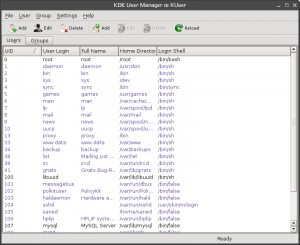
Users
Double-clicking a user opens a dialog with several tabs. The amount of tabs is variable, depending on the type of the user storage system and whether quotas are being used.
User Info
- Modify the user-properties like , , or set/change a for example. You can also .
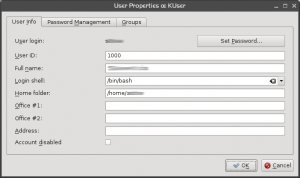
Password Management
- Change password settings, like the time after which a password has to be changed, or set a time at which an account will expire.
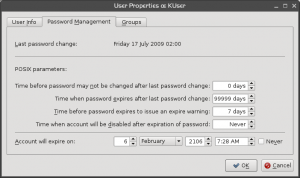
Groups
- Add or remove groups the user belongs to.
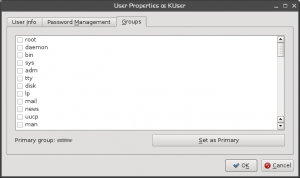
Groups
Double clicking a opens a dialog, where you can of the group and to/from a group.
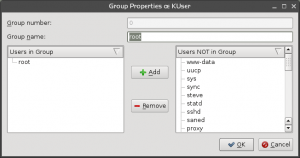

Warning
Be careful deleting anything, as it can harm your system seriously!
Configure KUser
Click and you can set up defaults for creating a new user:
General
- set the , the or the .
- choose if a will be created and if a (standard configuration files) will be copied to the home folder.
- set a , which creates a own personal group when a user is added and removes it, when the user is removed.
- set a .
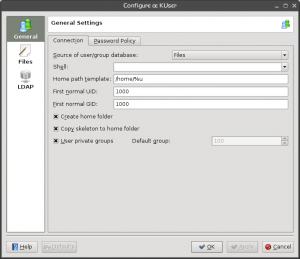
Files
- set default paths for password, group file, password shadow file and group shadow file.
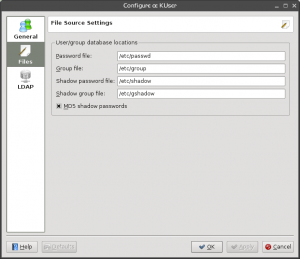
LDAP
- set preferences for users in a local network
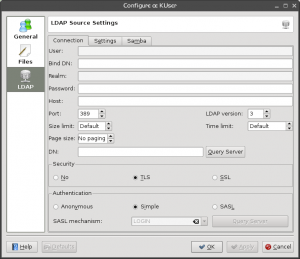

Tip
In most cases you won't have to change the default settings, as they are sufficient for most users.
